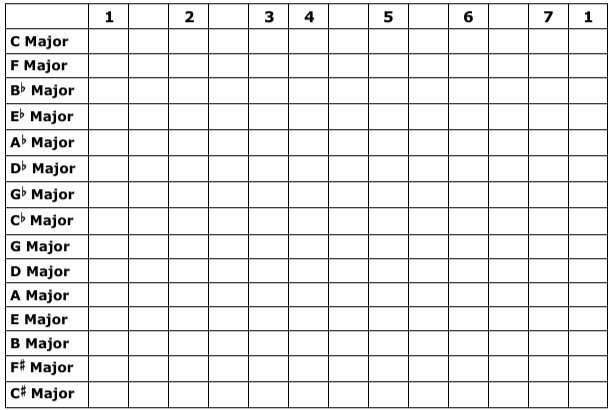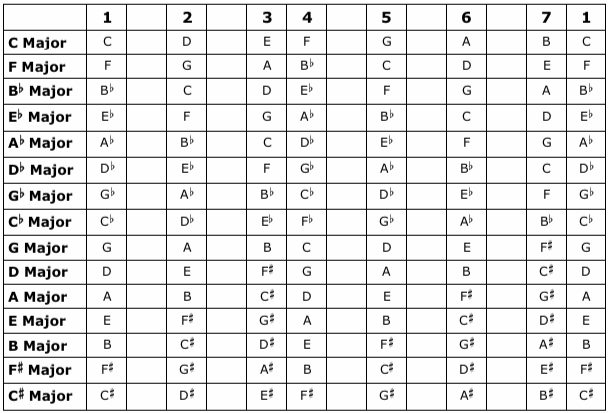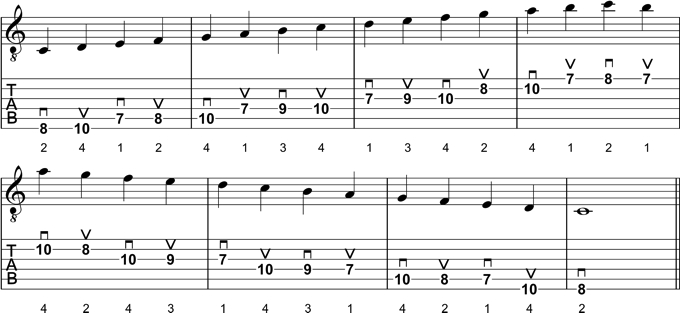The major scale is probably the most important scale there is. All other scales can be derived from it. If you totally understand the major scale you will be able to understand every other scale there is! Let’s take a close look at this very important scale…
You may have read in a book that the major scale has the following formula…
W W H W W W H
(W = Whole Step = 2 fret distance)
(H = Half Step = 1 fret distance)
So what does the above formula mean?
This formula tells you the distance between each note of the major scale. (Some geeky people like me call this the intervallic structure of the major scale).
As an example, here’s the F major scale mapped out on the thick E-string…

Please spend a couple of minutes looking at this diagram. What do you notice about it?
Here are a few observations:
- The distance between notes 1 and 2 is two frets (W).
- The distance between notes 2 and 3 is two frets (W).
- The distance between notes 3 and 4 is one fret (H).
- The distance between notes 4 and 5 is two frets (W).
- The distance between notes 5 and 6 is two frets (W).
- The distance between notes 6 and 7 is two frets (W).
- The distance between notes 7 and 1 is one fret (H).
All clear? Fantastic!
Because we all learn differently, here’s the same F major scale shown in a table format—this time with the note names shown…

Now, here’s a question for you. Why have I called the fourth note in F major “Bb” and not “A#”?
This brings us to an important rule…
![]()
In the example above, if we had called the fourth note A# it would mean we wouldn’t have some kind of a B in the scale.
I’ve found through my experience with teaching that people learn best by doing, so here is a great exercise for you to do…
Below is a table for you to print and fill out. You will need to work out the notes of all the major scales. Don’t be afraid of using your guitar to help you work out the notes. And don’t panic if you get stuck. I’ll be giving you the answers a little bit later…

OK. Now print out this page and take the time to fill out this table. Once you’re done, then you’re ready to continue reading. Please don’t skip filling out the table.
So how did it go?
The main area where people can get confused is with major scales that contain weird notes like Cb, B#, Fb and E#. A lot of students, for example, ask me “why do we call it a Cb and not B”? I then have to remind them of the following rule…
![]()
Let’s go through an example. Here is the Gb major scale…

Notice how the fourth note is a Cb. If we had called it a B, we wouldn’t be following the rule…
![]()
Yes, I know I’m repeating myself. But it’s that important. 🙂
You’ll notice that the “weird notes” Cb, B#, Fb and E# appear around the half-steps in the musical alphabet (E-F and B-C). Here are a couple of diagrams showing this…


I would highly recommend memorizing these diagrams. All you really need to understand is…
- Another name for B is Cb.
- Another name for C is B#.
- Another name for E is Fb.
- Another name for F is E#.
Right. That about covers this introduction to the major scale. Be sure to review this material on a regular basis. It’s important, because a great deal of music theory is derived from the major scale.
Oh yeah. Before I forget. I need to give you the answers to the table you filled out earlier. Here they are…

Putting It Into Practice
You need to get in the habit of playing what music theory you learn. This will allow you to both understand the theory better, and also help you be in a better position to apply it. So, with that in mind, here’s a really useful C Major scale fingering that I recommend learning now…
C Major Scale:

